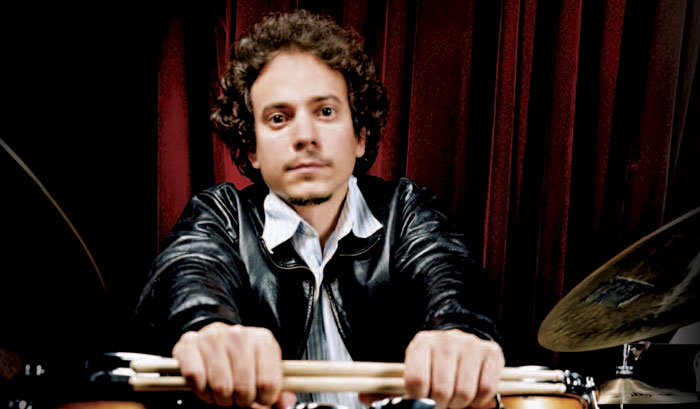


Is Dafnis Prieto a drummer who composes or a composer who drums?
It's hard to say, since the Cuban-born musician makes the two disciplines seem inseparable. "At this point in my career," he says, "composing on the drums is just as important as playing drums." Perhaps that's why Dafnis has been the drummer of choice for such esteemed jazz composers as Henry Threadgill, Steve Coleman, and Eddie Palmieri.
"There is an affinity there," agrees Prieto, who immigrated to New York City in 1999, at the age of 25. "Composers like to work with someone who can see the big picture, instead of just the drum side of things. Sometimes a drummer only plays drums and only thinks of drums, so all he hears is drums. But drums are only one part of music. I choose to express myself through drums because I identify with the instrument. But whether I'm playing with my own group or with someone else, I try to have an overview of all the music. I try to listen to what the trumpet, sax, and piano are doing, so I can play with them or against them to create the tension and release that music should have."
Your music isn't your work--it's who you are.
In fact, argues Prieto, all musicians should attempt to compose. "When you compose," he says, "you learn to become more aware of everything going on around you in the music."
Dafnis is no newcomer to "thinking outside the kit." During his eight years in Cuban conservatories, he studied mallet instruments, tympani, harmony, counterpoint, and piano. And he's always been attracted to avant-garde jazz, citing as heroes such iconoclastic bandleader/composers as Ornette Coleman, Egberto Gismonti, and Hermeto Pascoal. Equally influential were Cuba's fiery folk rhythms, especially as practiced by such drummers as Changuito and Tata Gčines, progressive players who melded Caribbean rhythms with jazz and rock.
Prieto brings a similar maverick spirit to his recordings as a bandleader, 2005's About the Monks and Dafnis Prieto Absolute Quintet, released earlier this year. Both fuse Cuban rhythms and abstract composition. Another boundary-breaking project are the drum/dance duets he performs with his wife, Judith Sanchez Ruiz, who is also a member of the famed Trisha Brown Dance Company.
Prieto is currently composing the music for his next project, funded by a Chamber Music of America New Works grant, which he won on the strength of an earlier brass quintet he'd composed for the Meridian Arts Ensemble. Unlike his first two albums, which featured string soloists, the new piece is for a sextet of two saxophones, trumpet, and a rhythm section. "I like changing instrumentation from album to album," he explains.
While Prieto is the sole percussionist on his own records, he often implies a larger drum ensemble, evoking bongos and timbales with his toms and snares. "I didn't study the traditional rhythms the way I studied classical music," he says. "That side of the music has been mostly intuitive to me. But lately I've been thinking I should study them in a more scholastic way, just so I can teach them better and make myself more complete as a Cuban musician."
The bright timbre needed to mimic Cuban percussion instruments is one reason Prieto opts for a Yamaha Maple Custom kit. "The brightness of the maple means I can integrate the sounds of timbales or bongos into the rim shots, for example. To me, the maple drums have a complete sound--they can be deep or light or bright. I can get so many sounds and textures from them. Plus the hardware is the best--it always feels completely comfortable."
Dafnis has played Yamahas since he was a kid in Cuba. "My very first kit was some secondhand East German socialist thing," he recalls. "But the first drums I bought myself were Yamahas. I've loved their sound ever since I heard Steve Gadd's recordings with Chick Corea."
Until recently Dafnis used a copper Roy Hanes signature snare, but he acquired a custom drum during a recent visit to the Yamaha Drums factory in Japan. "It's a thick, deep snare, 14"x7". I'm just starting to use it." He opts for a taut 18"x16" bass drum and 10"x7.5", 12"x8", and 14"x14" toms. "I tune the toms a little high," he explains, "usually something like G, C, G. But it's not exact--I tune by ear, and I tend to change the tuning to suit the room I'm playing in."
When Dafnis cites such influences as Ornette Coleman, Egberto Gismonti, and Hermeto Pascoal, he's talking about more than their music. "I'm just as influenced by the spirit that runs through what they do," he says. "That spirit becomes a way of life. Your music isn't your 'work'--it's who you are. My music is the way I think, the way I walk, the way I talk. That's the way I want to live."
























